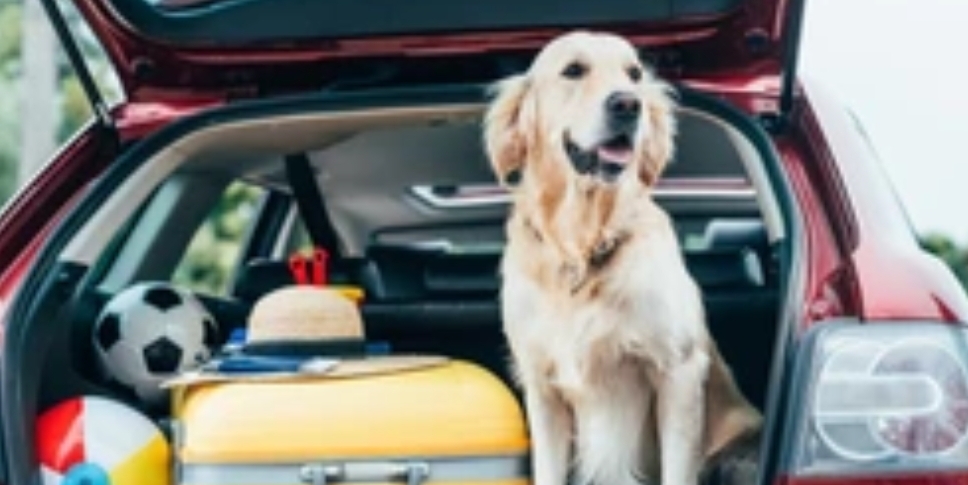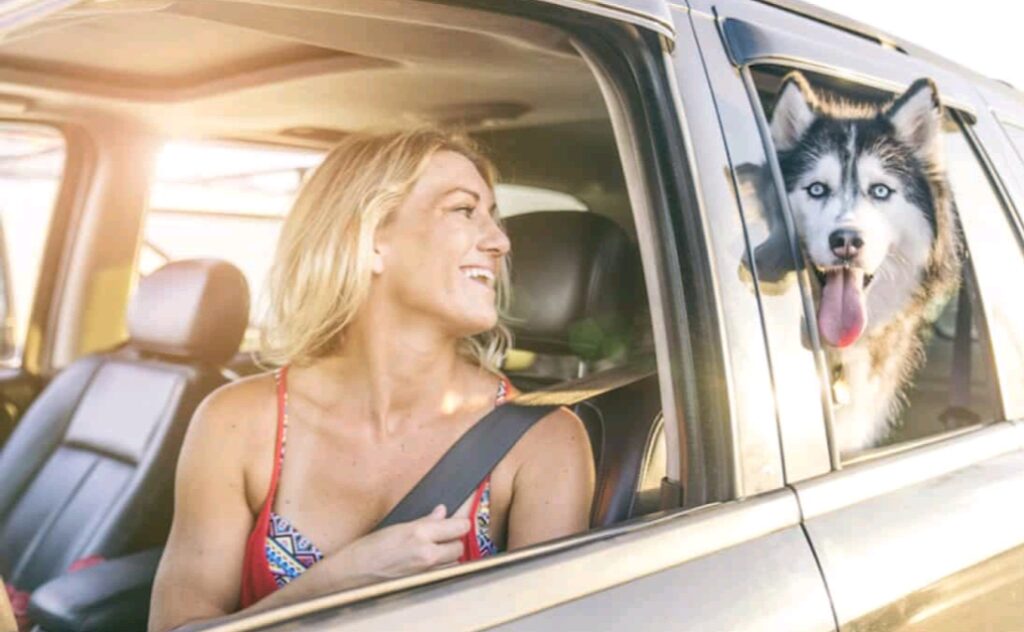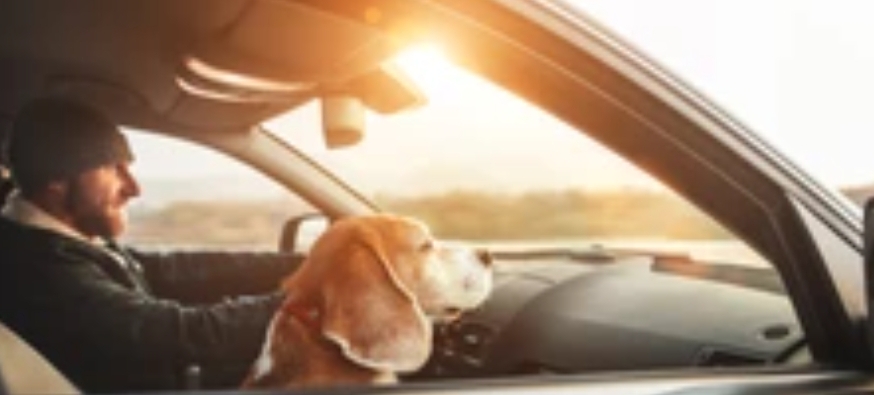Summer is here, and that often means road trips and vacations with the whole family – your dog included! However, the sweltering heat can be a challenge, especially when transporting your furry friend. Your dog’s comfort and safety should always be a priority. This article, “How to Keep Your Dog Cool in the Car During the Summer!“, is designed to give you practical tips and strategies to ensure your dog stays cool and comfortable, even during long car rides.
“A dog is the only thing on earth that loves you more than he loves himself.” – Josh Billings
Traveling with your pet can be a joyful experience if done safely. Understanding the risks, choosing the right car, packing essential items, preparing your dog for the journey, and knowing how to keep your dog cool during the ride are all critical elements of a successful and safe road trip. This guide will also provide you with tips on managing pit stops and emergency measures if your dog overheats. The journey doesn’t end once you reach your destination – we’ll share insights on how to continue keeping your dog cool after you’ve arrived.

The risks of leaving your dog in a hot car
As we delve into the summer months, the topic of keeping your dog cool during a car ride becomes increasingly important. But why is it so crucial? Let’s discuss the risks associated with leaving your dog in a hot car.
It may surprise you, but the temperature inside a car can rise very quickly, even when it doesn’t feel that hot outside. In fact, on an 85-degree day, the temperature inside a car with the windows cracked can reach 102 degrees in just 10 minutes. After 30 minutes, the temperature can soar to 120 degrees or higher. This can have devastating consequences for your furry friend.
Heatstroke
Heatstroke is a very real and dangerous risk for dogs left in hot cars. Dogs can’t sweat like humans do and rely on panting to cool themselves down. In a hot environment, panting is simply not enough. Heatstroke can cause organ failure, brain damage, and even death in severe cases.
Dehydration
Dehydration is another risk that your dog faces when left in a hot car. If your dog doesn’t have access to water, they can become dehydrated quickly. Dehydration in dogs can lead to serious health issues including kidney failure, shock, and heatstroke.
Stress and Anxiety
Dogs in hot cars can also experience high levels of stress and anxiety. The intense heat, coupled with the inability to escape the situation, can result in a fearful and anxious dog. Stress and anxiety not only affect your dog’s mental wellbeing but can also have long-term effects on their physical health.
Understanding the risks associated with leaving your dog in a hot car is the first step towards ensuring their safety. Now, let’s move on to choosing the right car to keep your dog cool and comfortable.
How to choose the right car for your dog
Dogs, especially older or smaller ones, may find it challenging to climb into high vehicles such as SUVs or trucks. Vehicles with low entry points, or cars equipped with ramps or steps how comfortable your dog remains during the trip, and can even impact their overall health and wellbeing. Here are some factors to consider when choosing a car that will be conducive to keeping your dog cool and comfortable.
, can makeSize of it the Car easier for your dog to enter and exit the vehicle.
The size of
the car is a fundamental factorWindows
. Dogs requireWindows can adequate provide space additional to ventilation move and stretch, especially, but during they also long journeys. A cramped space can cause discomfort, and it may present a exacerb potential risk if a dog sticksate the heat its head, making it more difficult for your dog to keep cool. A out while larger the car vehicle is such as an SUV or moving a minivan can provide sufficient. Power windows that can be locked are space an important for safety feature to prevent your accidental dog window movement, and allow. for
In addition to these factors better, prospective car air circulation owners with dogs should. also consider vehicles
V with durableentilation and, easy Air Conditioning-to-clean interiors , as
dogs can often bringProper ventilation dirt and is crucial shed in fur helping to reduce into the the car temperature. Remember inside the car, the. Vehicles with good safety and ventilation comfort of your canine systems companion should be and a top priority air when conditioning choosing a vehicle for can summer help travel maintain a comfortable temperature for your. dog
What to pack for your dog’s comfort
dog during the summer, it is essential to pack items that will keep your dog comfortable and cool. The right supplies can alleviate stress and make the drive more enjoyable for both you and your pet.
Water and Hydration Accessories
The most crucial item to pack is water. Dehydration can quickly affect dogs in warm cars, so ensure you have enough fresh, cold water on hand for the duration of your journey. Pack a spill-proof water bowl or a specially designed pet drinking bottle for easy hydration on the move.
Cooling Accessories
- Cooling Mats: These portable mats are filled with a cooling gel that activates when your dog lies on it, providing a cool surface for your pet.
- Cooling Bandanas or Vests: These items can be soaked in water and worn by your dog. The water evaporates slowly, helping to keep your dog cool.
Comfort Items
Remember to bring items that are familiar to your dog to make the car environment more comfortable. This could include their favorite blanket or toy. It’s also a good idea to bring a pet bed or crate if you have room, as this can provide a secure, familiar place for your dog to rest during the journey.
Shade-Providing Accessories
Lastly, consider packing window shades or screens. These can be affixed to the windows to help block out the sun, providing an extra layer of protection from the heat.
In sum, the key to a successful journey with your pet during the summer months is preparation. Ensure that you pack all the necessary items to keep your dog cool and comfortable throughout the trip.
How to prepare your dog for the journey
car journey during summer is crucial in maintaining its comfort and wellbeing. This preparation involves acclimating your dog to the car, conditioning it against motion sickness, and ensuring it has had recent health checks, among other things.
Acclimating the Dog to the Car
Firstly, one should get the dog used to being in the car. This can be achieved through short, frequent trips in the car, gradually increasing the duration. The aim is to make the dog view the car as a safe and comfortable space. Also, the dog should be trained to enter and exit the car calmly and safely.
Addressing Motion Sickness
Secondly, motion sickness is a common issue for dogs during car rides. Therefore, it’s essential to condition your dog against this. Suggestions include not feeding your dog immediately before the journey, and ensuring that the dog faces forward during the journey. If motion sickness persists, consulting a veterinarian for potential medication might be necessary.
Ensuring Recent Health Checks
Before embarking on a long car journey, it is advisable to take your dog for a recent health check. This is to ensure that the dog is fit for the journey and to gain professional advice on how to manage any existing health issues during the trip.
Packing Essentials
Packing essentials for the journey is another important aspect of preparation. Essentials include water and hydration accessories, cooling accessories, comfort items, and shade-providing accessories. These items not only provide a comfortable environment for the dog, but also equip the owner to handle any emergencies that might arise.
Planning the Journey
Lastly, plan your journey with your dog in mind. This means considering the temperature outside and inside the car, planning regular pit stops for bathroom breaks and exercise, and identifying pet-friendly places along the route.
In conclusion, preparing your dog for the journey involves a holistic approach that considers the dog’s needs, comfort, and safety. Following these steps will help ensure a more comfortable and enjoyable journey for your beloved pet.
Tips for keeping your dog cool during the car ride
When embarking on a long car ride during the summer with a pet, it’s essential to take certain measures to ensure the dog’s comfort and safety. By implementing appropriate strategies, owners can significantly reduce the risk of their furry friends experiencing heat-related illnesses.
Temperature Regulation
First and foremost, the temperature of the car should be regulated. The air conditioning should be turned on to maintain a cool environment inside the vehicle. It’s advisable to pre-cool the car before the dog enters. However, be mindful of the fact that dogs, especially breeds with heavy coats, can also get cold quickly. The aim is to strike a balance and maintain a temperature that is neither too hot nor too cold.
Proper Ventilation
As important as temperature control is, so is proper ventilation. It’s essential that fresh air circulates throughout the vehicle. While it’s not advisable to allow dogs to stick their heads out of the window due to potential hazards, slightly opened windows can significantly improve airflow.
Frequent Breaks
Even with all these measures, dogs can still overheat if they remain in a car for too long. Therefore, frequent breaks are recommended. This gives the dog a chance to cool down, hydrate, and relieve themselves. It can also help reduce their stress and anxiety levels linked to long journeys.
Hydration
During the car ride, it’s crucial to keep the dog hydrated. Keep a bowl of fresh water accessible to the dog at all times. There are also a variety of hydration products designed specifically for travelling with pets, such as non-spill water bowls and portable water dispensers.
Cooling Accessories
Finally, consider using cooling accessories such as cooling mats, vests, or bandanas. These items can provide additional relief from the heat, especially for breeds prone to overheating. However, remember to introduce these items to the dog before the trip to ensure they are comfortable with them.
In conclusion, keeping a dog cool during a long car ride requires careful planning and attention to detail. With the right approach, you can ensure a comfortable and safe journey for your four-legged friend.
How to make pit stops comfortable and safe for your dog
Pit stops are not just important for the driver, but also for your canine friend. It’s an opportunity for your dog to stretch, hydrate, and cool down, especially during hot summer trips. Here’s how you can make pit stops comfortable and safe for your dog.

Plan your stops
Long trips especially require you to plan your stops strategically. Ideally, you should stop every 2-3 hours to allow your dog the chance to move around and relieve himself. Remember, dogs are sensitive to heat, so choose locations which offer shade and grassy areas where your dog can roam freely.
Never leave your dog unattended
Leaving your dog unattended in the car is risky, especially during the summer. If you need to use the restroom or grab a bite to eat, take turns with another passenger if possible, or consider using drive-thrus and outdoor dining areas so your pet can stay with you.
Bring necessary items
Bring a leash, water bowl, and your dog’s favorite treats to keep him comfortable during the pit stop. It’s also a good idea to bring poop bags to clean up after your dog. Remember, not every place you stop will have the supplies you need.
Keep your dog on a leash
Even if your dog is well-behaved, keep him on a leash during pit stops. This will prevent him from running into traffic, getting lost, or encountering other animals. It’s also a sign of respect to other people who might be afraid of dogs.
Monitor your dog
Monitor your dog for any signs of distress or overheating during the pit stop. Look for signs such as excessive panting, drooling, difficulty breathing, or weakness. If your dog shows any of these signs, seek veterinary attention immediately.
In conclusion, pit stops are an essential part of long car journeys with your dog, particularly in the summer. By planning your stops, never leaving your dog unattended, bringing necessary items, keeping your dog on a leash, and monitoring your dog’s behavior, you can ensure that pit stops are both comfortable and safe for your dog.
Emergency measures to take if your dog overheats
Should a situation arise where your dog shows signs of overheating, immediate and decisive action is necessary to prevent potential complications such as heatstroke. The following are emergency measures to employ.
Recognize the Signs
Before taking action, it’s crucial to recognize the signs of overheating in dogs, which may include excessive panting or difficulty breathing, increased heart and respiratory rate, drooling, mild weakness, stupor, or even collapsing. More severe symptoms can involve seizures, bloody diarrhea and vomit, along with an elevated body temperature of over 104 degrees.
Remove the Dog from the Heat
As soon as the signs of overheating are noticed, immediately remove the dog from the hot environment. This action might involve moving to a shaded area, stepping inside an air-conditioned building, or simply exiting the vehicle.
Begin to Cool the Dog Down
After removing the dog from the heat source, start cooling them down gradually. Wet the dog with cool, but not cold, water. Pay attention to the underbelly and areas around the ears and paws. A fan can be used to aid in the cooling process. It is important to avoid using ice water, as it can cause the blood vessels to constrict, impeding the cooling process.
Hydrate
Offer the dog cool, fresh water, but do not force them to drink. Overhydration can lead to a dangerous condition known as water intoxication.
Seek Veterinary Attention
After initial cooling, bring the dog to the veterinarian as soon as possible. Even if your dog seems fine after cooling down, a check-up is still necessary to rule out internal complications such as kidney failure, neurological disorders, abnormal clotting, and other potential issues related to overheating.
Remember, keeping a dog cool in the car during summer travels is a matter of safety and comfort. Following these guidelines and taking the necessary steps in case of overheating can ensure that your four-legged friend stays healthy and enjoys the journey.
How to continue keeping your dog cool once you reach your destination
Once the journey concludes and both the pet owner and their dog have arrived at their intended destination, it is crucial to continue employing measures to keep the dog cool. This stage is just as essential as the travel itself, especially if the destination is a location with a high-temperature environment.

Immediate and Continuous Hydration
Dogs can lose a significant amount of water from panting during their travel. Upon arrival, provide your dog with fresh, cool water promptly. Continue to ensure your dog remains hydrated, particularly if you are staying in a hot climate. A water dish should always be within reach.
Shade Accessibility
Whenever possible, ensure that your dog has access to shaded areas. Whether this is under a tree or an awning, it is imperative to offer an escape from the sun’s heat. A portable shade tent can be a useful investment for such occasions.
Temperature and Air Circulation
Monitor the temperature within your accommodation and ensure there is sufficient air circulation. If you are staying somewhere with air conditioning, ensure it is functional and set to a comfortable temperature. If air conditioning is not available, use fans to help circulate air and provide a breeze for your dog.
Cooling Accessories
Continue to utilize any cooling accessories you brought for the journey, such as cooling mats and cooling vests. These can provide much-needed relief for your dog, especially during the hottest parts of the day.
Avoid Peak Heat Hours
Try to keep your dog indoors during the peak heat hours of the day, typically between 10 am and 4 pm. If your dog needs to go outside during these hours, limit the duration and intensity of their activities.
Regular Checkups
Lastly, keep a close eye on your dog’s behavior and physical signs. If you notice symptoms of heatstroke or dehydration, such as excessive panting, lethargy, or a bright red tongue, take immediate action to cool your dog down and consult a veterinarian if necessary.